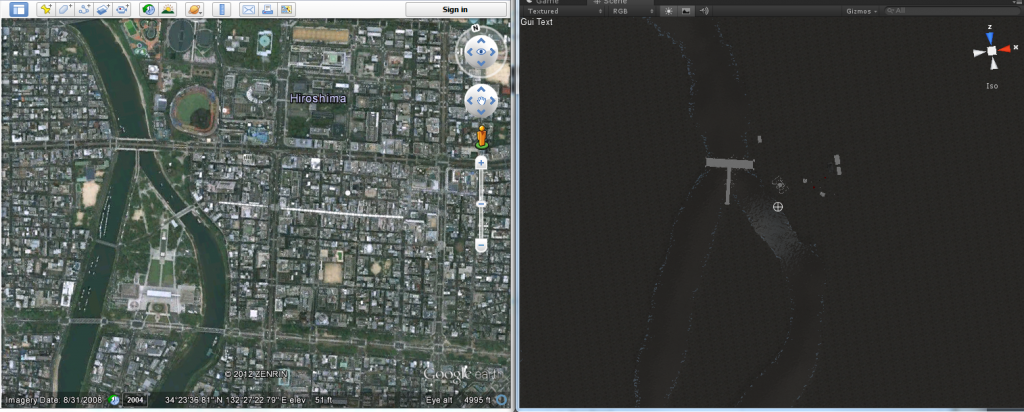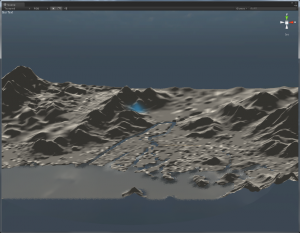Scaling Woes
 One issue that we’ve been wrestling with a lot this week is scaling our world. Because we now have a fairly accurate geographical representation of the land around Hiroshima, there’s a certain expectation that the rest of the world (buildings, trees, people, other props) will be more or less true to life as well. A (close to) 1:1 scale isn’t necessarily difficult to achieve just by eyeballing it with Google Earth, and a 1:1 scale “feels” really “right,” whatever that means. However, there are some challenges associated with such a literal recreation:
One issue that we’ve been wrestling with a lot this week is scaling our world. Because we now have a fairly accurate geographical representation of the land around Hiroshima, there’s a certain expectation that the rest of the world (buildings, trees, people, other props) will be more or less true to life as well. A (close to) 1:1 scale isn’t necessarily difficult to achieve just by eyeballing it with Google Earth, and a 1:1 scale “feels” really “right,” whatever that means. However, there are some challenges associated with such a literal recreation:
Demo 9/28/12
Heightmapped Hiroshima demo is up! Anabelle helped me carve out the rivers with greater definition. The mountains still need to be smoothed, and the land by the river is a little unnaturally flat, but the overall impression is, if I may toot our horn here, quite beautiful. Check it out!
A ♪ From the Composer:

Writing an effective soundtrack for this interactive experience is an exciting and interesting challenge. The subject matter is already so emotionally charged, that the tone of the score needs to be just right. It needs to have an emotional resonance, but if you steer right into the emotion you run the risk of it being too saccharine and twee. Additionally, I want the score to have a Japanese flavor to it. To that end, I’ve been studying the pentatonic scale that’s so common in Asian music. Composing in this scale is totally new to me, so it’s been fascinating.
I’ve been finding the pentatonic scale somewhat tricky. The major scale completely omits the fourth and the seventh of the western major scale. The minor pentatonic scale omits the second, and the sixth. I’ve also been studying specific Japanese scales that are based on the pentatonic scale but with some variations. These include the Hirajoshi scale, the Kumoi, and Iwato scales. The Hirajoshi scale for example, omits the major third, fourth and seventh. The Kumoi scale uses the root, perfect fourth and fifth, omits the third, but uses a minor second, and minor sixth. I’ve been experimenting with melodies given these limitations and at the end of the day, I think that I’ll end up borrowing from whatever scales help illustrate the mood in the experience best. I’m a big fan of soaking in what I can and seeing what happens organically. In this case structural fidelity might not be the best thing.
Finding just the right instruments will be key to the feel of the experience as well. Utilizing percussion will be especially important. Well used percussion could give the piece a visceral feel, especially if I can use taiko drums to simulate a heartbeat. Also, I’ve been playing around with a synthesized shakuhachi, which is a bamboo flute, and a synthesized shamisen, which could be described as a Japanese three stringed guitar.
Thus far, the ambient music that I’ve written actually uses a lot of open fifths that are so common in Asian music, but I didn’t stick to the “rules” of the pentatonic scales so strictly and I’ve deliberately used dissonant sounds and the seventh of the scale to really feel like it’s leading you somewhere dramatic.
Heightmapping Japan
 So I decided that carving out rivers and mountains in Unity’s terrain editor by hand would probably make me suicidal, and since Anabelle and Noreen have enough work to do, I figured I’d look for some heightmaps of Japan. Turns out that, once again, Google has all the answers.
So I decided that carving out rivers and mountains in Unity’s terrain editor by hand would probably make me suicidal, and since Anabelle and Noreen have enough work to do, I figured I’d look for some heightmaps of Japan. Turns out that, once again, Google has all the answers.
Using Google Earth, a plugin called Ambiotek (direct download link), and a mapping tool called MicroDEM written by a Professor Peter Guth of the US Naval Academy’s Oceanography Department, I was able to extract a heightmap from Google Earth and import it into Unity. And I have to say…it totally kicks ass.
Demo 9/21/12
Newest demo is up! We were in DC Thursday and Friday, so I forgot to post it until just now. But everyone can exhale now…here it is!